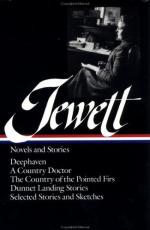|
This section contains 2,239 words (approx. 8 pages at 300 words per page) |

|
SOURCE: “‘Once Upon a Time’: Sarah Orne Jewett's ‘A White Heron’ as a Fairy Tale,” Studies in Short Fiction, Vol. 15, No. 1, Winter, 1978, pp. 63–68.
In the essay below, Hovet demonstrates how “A White Heron” employs the fairy tale structure as defined by Vladimir Propp.
Sarah Orne Jewett's “A White Heron” is one of the most admired of nineteenth-century American short stories. It has frequently been praised for its delicate artistry and, more recently, for its treatment of the heroine.1 In spite of its enduring critical reputation, however, the structure of the story has not been carefully analyzed. As a result, Jewett's use of the fairy tale form has been neither recognized nor appreciated. The application of “the morphology of the fairy tale,” to use Vladimir Propp's phrase, not only describes the artistic structure of the story but also reveals how Jewett turned to the fairy tale in order to...
|
This section contains 2,239 words (approx. 8 pages at 300 words per page) |

|


